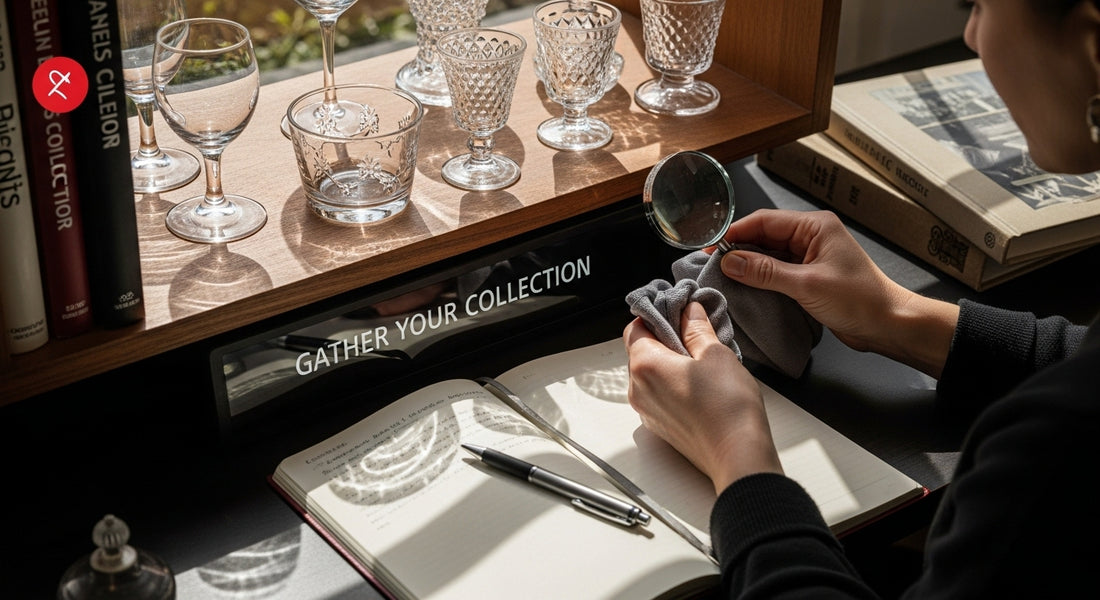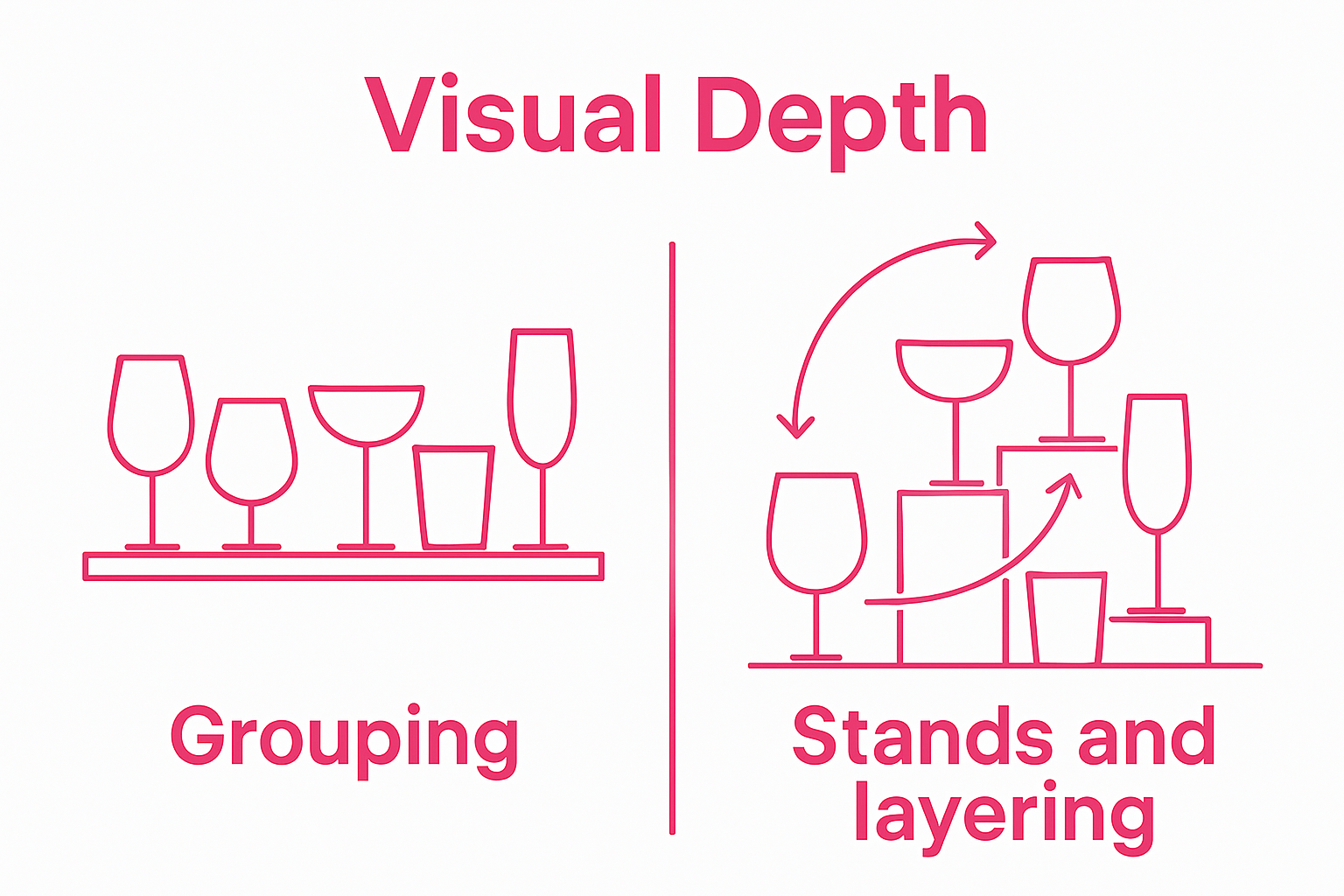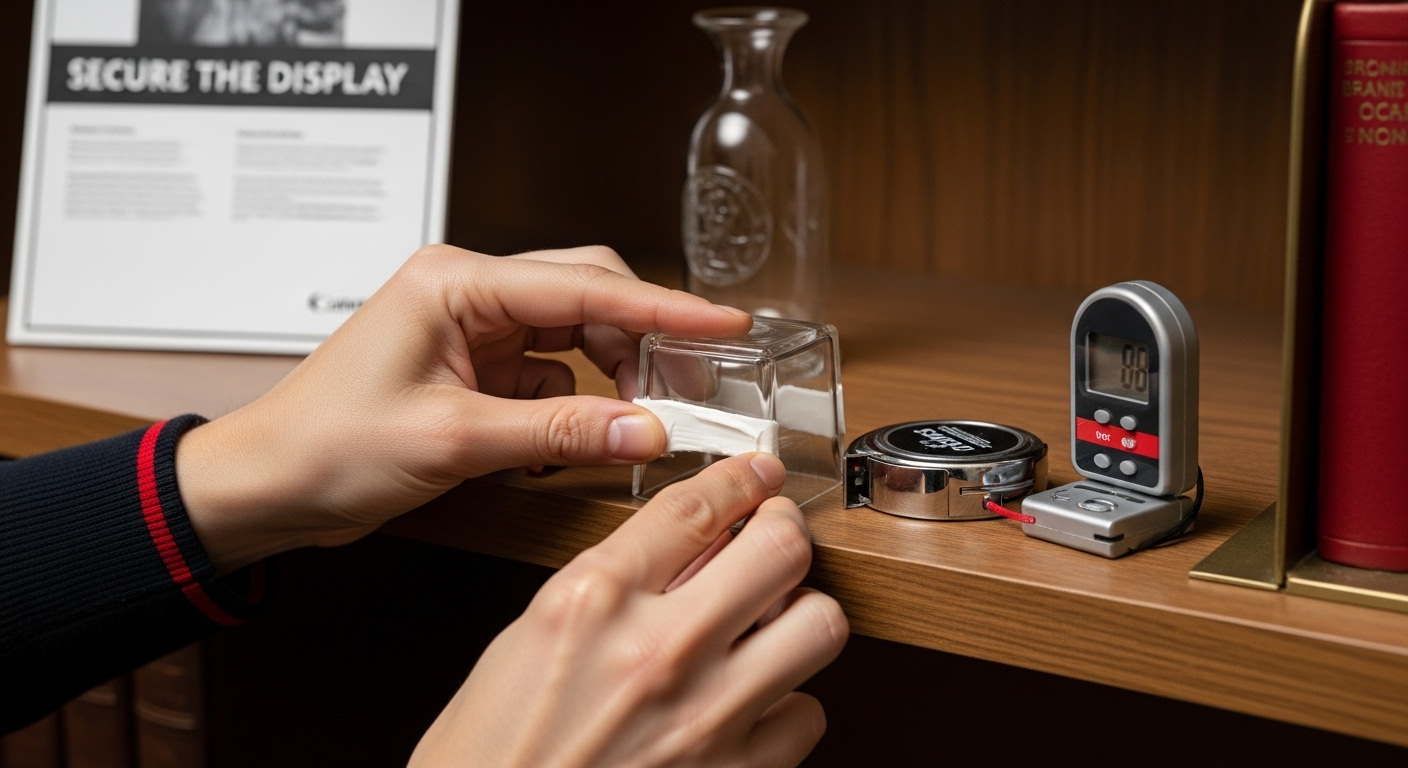
How to Display Vintage Glassware: Create a Stunning Showcase
Share
Vintage glassware catches more than just a bit of sunlight in South African homes. Some pieces on display are more than 100 years old and every etching tells a part of our history. Most people think it is about finding the oldest glass, but that is just a small part of the story. The real magic is how you turn your collection into a jaw-dropping display that speaks volumes without you saying a word.
Table of Contents
- Step 1: Gather Your Vintage Glassware Collection
- Step 2: Choose The Right Display Area
- Step 3: Select Complementary Display Items
- Step 4: Arrange Glassware For Maximum Impact
- Step 5: Secure The Display For Safety
- Step 6: Review And Adjust For Aesthetic Balance
Quick Summary
| Key Point | Explanation |
|---|---|
| 1. Start with careful selection. | Understand the unique characteristics and provenance of each piece to enhance your collection. |
| 2. Document your collection thoroughly. | Create an inventory that includes manufacturing date, origin, and condition to track and personalise your display. |
| 3. Choose a suitable display area. | Select a space with soft, indirect lighting and stable conditions to enhance and protect your glassware. |
| 4. Arrange for visual impact. | Establish a visual hierarchy by strategically layering and grouping pieces for dimensionality and interest. |
| 5. Ensure safety and stability. | Use secure display options to prevent accidents and preserve your glassware’s integrity against environmental risks. |
Step 1: Gather Your Vintage Glassware Collection
Building a stunning vintage glassware display begins with careful collection and thoughtful selection. Your journey starts with understanding the unique characteristics and historical significance of the pieces you want to showcase. South African collectors and enthusiasts know that vintage glassware represents more than just decorative objects they are windows into cultural heritage and craftsmanship.
Start by surveying your existing collection or planning an intentional acquisition strategy. Seek out pieces with distinctive features such as hand-blown designs, unique etching patterns, or regional manufacturing marks. Local antique shops, estate sales, and specialized vintage markets are excellent hunting grounds for these treasures. Pay close attention to the condition of each piece glass that is free from significant chips, cracks, or extensive wear will form the foundation of your display.
When evaluating potential additions to your collection, consider several key factors. Look for glassware with clear provenance or interesting historical context those pieces that tell a story will become conversation starters in your display. The age, origin, and manufacturing technique of each item contribute to its collectible value. Read more about vintage collecting techniques to refine your selection process and develop a discerning eye.
Documenting your collection is equally important. Create a detailed inventory that includes critical information for each piece:
- Date of manufacture
- Place of origin
- Unique identifying characteristics
- Estimated historical or monetary value
- Condition assessment
This documentation not only helps you track your collection but also provides valuable context when you eventually create your display. Proper documentation transforms your glassware from mere objects into a curated historical narrative that celebrates craftsmanship and design across different eras.
Step 2: Choose the Right Display Area
Selecting the perfect display area transforms your vintage glassware collection from a simple assemblage of objects into a captivating visual narrative. The right location can dramatically enhance the aesthetic and historical significance of your pieces, turning them into a focal point that draws admiration and sparks conversation.
Carefully consider the environmental conditions that will impact your display. Natural light can beautifully illuminate glass, but direct sunlight can cause discoloration and damage delicate pieces. Look for areas with soft, indirect lighting that will highlight the intricate details of your glassware without risking its preservation. Spaces near windows with sheer curtains or rooms with subtle ambient lighting work exceptionally well. Learn more about displaying collectibles with style to refine your approach.
The structural integrity of your display area is crucial. Choose surfaces that are stable, level, and capable of supporting the weight of your collection. Avoid high-traffic areas or locations prone to accidental bumping. Shelving units, dedicated display cabinets, or purpose-built glass display cases provide ideal environments that protect your vintage glassware while showcasing their beauty.
Consider the surrounding decor and color palette of your chosen display area. Neutral backgrounds work best, allowing the unique characteristics of each glass piece to stand out. White, soft grey, or muted earth tones create an elegant backdrop that doesnt compete with the glassware itself. The display area should complement your pieces, creating a harmonious visual environment that tells a story.
Before finalizing your display location, perform a comprehensive assessment:
- Check for stable temperature and humidity levels
- Ensure minimal dust accumulation potential
- Verify adequate lighting conditions
- Confirm protection from direct sunlight and potential impacts
- Assess visibility and aesthetic integration with room design
Remember that your display area is more than just a physical location its a curated space that celebrates the history and craftsmanship of your vintage glassware collection.
Below is a summary table of the main steps to creating a stunning vintage glassware display, including the focus of each stage and desired outcome for South African collectors.
| Step | Focus Area | Key Action | Desired Outcome |
|---|---|---|---|
| 1 | Collection & Documentation | Select and document unique, historical glassware pieces | Curated, well-tracked collection |
| 2 | Display Area Selection | Choose suitable location with optimal lighting and controlled environment | Enhanced beauty and preservation |
| 3 | Complementary Items | Select accessories and textures to support the glassware | Cohesive, visually appealing display |
| 4 | Arrangement | Arrange glassware for flow, dimension and narrative | Captivating visual story |
| 5 | Safety & Stability | Secure display area and protect from risks | Safe, resilient showcase |
| 6 | Aesthetic Refinement | Review, adjust and balance for harmony | Elegant and balanced presentation |
Step 3: Select Complementary Display Items
Completing your vintage glassware display requires strategic selection of complementary items that enhance rather than overshadow your primary collection. The art of curating lies in creating visual harmony while allowing each piece to tell its unique story. Think of your display as a carefully composed visual symphony where each element plays a supporting role.
Consider incorporating materials and textures that create interesting visual dialogues with your glassware. Antique brass candlesticks, delicate porcelain figurines, or aged wooden platforms can provide stunning contrast and depth to your glass collection. These supporting elements should whisper historical context without competing for attention. Explore vintage display techniques to refine your approach and understand nuanced styling principles.
Color plays a critical role in creating a cohesive display. Select complementary items with muted, neutral tones that allow your glassware to remain the focal point. Soft earth tones like sage green, warm beige, or gentle greys work wonderfully. Avoid bold, saturated colors that might distract from the delicate nature of vintage glass. The goal is to create a sophisticated backdrop that elevates your collection without overwhelming it.
Texture becomes another essential consideration when choosing display companions. Incorporate items with subtle textural variations textured ceramic bases, woven linen runners, or aged metallic accents can add visual interest while maintaining a refined aesthetic. These tactile elements create depth and invite closer examination of your carefully curated collection.
Before finalizing your complementary items, evaluate each potential addition using these criteria:
- Maintains historical authenticity
- Provides subtle visual contrast
- Enhances rather than competes with glassware
- Contributes to overall narrative of the display
- Represents appropriate scale and proportion
Remember that restraint is key. Each additional item should serve a deliberate purpose in your display, contributing to a sophisticated narrative that celebrates the beauty and history of your vintage glassware collection.
Step 4: Arrange Glassware for Maximum Impact
Arranging vintage glassware is an art form that requires careful consideration of visual balance, historical narrative, and structural integrity. The strategic placement of each piece transforms a simple collection into a compelling visual story that invites exploration and admiration. Your arrangement should guide the viewers eye through a carefully choreographed journey of shapes, colors, and historical significance.
Begin by establishing a visual hierarchy that draws attention to your most exceptional pieces. Larger or more intricate glassware items should occupy central or elevated positions, creating natural focal points. Consider creating depth through strategic layering by placing smaller pieces in front of or beside larger items, allowing each piece to be partially visible and creating a sense of dimensionality. Discover advanced display techniques to elevate your presentation skills.
Height variation is crucial in creating a dynamic display. Use risers, specialized glass stands, or carefully selected complementary items to create different elevation levels. This approach prevents monotony and encourages viewers to explore the entire collection. Experiment with asymmetrical arrangements that feel organic and intentional rather than rigidly structured. The goal is to create visual movement that guides the observers gaze naturally across your display.

Pay close attention to the relationships between individual pieces. Group glassware with similar characteristics color families, historical periods, or manufacturing techniques to create cohesive visual narratives. However, introduce subtle interruptions in these groupings to maintain visual interest and prevent predictability. Negative space is just as important as the objects themselves allowing breathing room that prevents the display from feeling cluttered.
Before finalizing your arrangement, evaluate your display using these critical criteria:
- Maintains clear visibility of each piece
- Creates natural visual flow
- Highlights unique characteristics of individual items
- Provides structural stability
- Tells a compelling visual story
Remember that your arrangement is a living composition. Dont be afraid to experiment, step back, and reassess. The perfect display often emerges through patient refinement and a willingness to see your collection from multiple perspectives.
Step 5: Secure the Display for Safety
Securing your vintage glassware display is not merely about preservation its about protecting a delicate historical narrative from potential accidents and environmental risks. Safety transforms your carefully curated collection from a fragile arrangement into a resilient showcase that can withstand everyday interactions while maintaining its aesthetic integrity.
Begin by assessing the structural stability of your display surface. Glass display cabinets with secure locking mechanisms provide the ultimate protection, creating a physical barrier that prevents accidental touching while allowing visual appreciation. If using open shelving, consider museum-grade adhesive mounting putty or specialized glass display stands that offer subtle yet effective stabilization. These solutions provide gentle support without compromising the visual elegance of your collection. Explore professional display techniques to enhance your preservation strategy.
Environmental factors pose significant risks to vintage glassware. Minimize potential damage by controlling temperature and humidity in your display area. Avoid placing your collection near heating vents, air conditioning units, or windows with direct sunlight. Sudden temperature fluctuations can cause stress fractures in delicate glass pieces. Consider investing in a small hygrometer to monitor ambient conditions, maintaining a consistent environment that protects your precious collection from subtle yet destructive environmental changes.
Child and pet safety requires proactive planning. If you have curious children or active pets, consider display options that provide additional protection. Lockable display cabinets, high shelving units, or dedicated display rooms offer comprehensive safety solutions. For open displays, create physical barriers using clear acrylic stands or strategically positioned decorative screens that prevent direct contact while maintaining visual accessibility.
Before finalizing your safety approach, evaluate your display using these critical checkpoints:
- Prevents accidental physical contact
- Maintains stable environmental conditions
- Protects against potential damage sources
- Allows clear visibility of collection
- Integrates seamlessly with room design
Remember that securing your vintage glassware is an ongoing process. Regular inspection, careful maintenance, and adaptive safety strategies will ensure your collection remains pristine for years to come.
Use this checklist to evaluate critical safety and presentation criteria before finalising your vintage glassware display, ensuring your collection is both protected and visually impressive.
| Criteria | Yes/No | Notes |
|---|---|---|
| Stable, secure display surface | ||
| Protected from direct sunlight | ||
| Suitable temperature & humidity | ||
| Physical barriers for children/pets | ||
| Adequate lighting for visibility | ||
| Prevents accidental contact | ||
| Integrated with room decor | ||
| Display tells a clear visual story |

Step 6: Review and Adjust for Aesthetic Balance
Aesthetic balance represents the final transformative stage in creating a stunning vintage glassware display. This step is about refinement, where subtle adjustments can elevate your collection from merely attractive to truly captivating. Think of yourself as a curator, carefully orchestrating a visual symphony that tells a compelling story through your carefully selected pieces.
Begin by photographing your initial display from multiple angles. This technique provides an objective perspective that allows you to see your arrangement with fresh eyes. Digital documentation helps identify asymmetries, visual clutter, or areas lacking visual flow that might not be immediately apparent when standing directly in front of the display. Explore professional lighting techniques to enhance the visual impact of your glassware showcase.
Careful observation requires stepping back both literally and metaphorically. Spend time viewing your display from different distances and perspectives. Create visual breathing room by strategically incorporating negative space between pieces, allowing each item to maintain its individual character while contributing to the overall composition. This approach prevents visual overcrowding and invites viewers to appreciate the nuanced details of each glass piece.
Color and texture play crucial roles in achieving aesthetic balance. Assess how light interacts with your glassware, noting how shadows and reflections enhance or detract from the display. Subtle adjustments in positioning can dramatically alter the visual narrative. Rotate pieces slightly, experiment with different heights, and be willing to remove items that disrupt the overall harmony. The goal is to create a display that feels intentional yet effortlessly elegant.
Before finalizing your display, evaluate using these critical aesthetic criteria:
- Maintains clear visual hierarchy
- Provides balanced color distribution
- Creates natural viewing flow
- Highlights unique characteristics of individual pieces
- Evokes emotional response or narrative
Remember that aesthetic balance is an ongoing process. Your display should feel alive and adaptable, inviting periodic reexamination and gentle refinement. Trust your intuition, but also be open to unexpected arrangements that surprise and delight.
Curate Your Vintage Display and Amplify Your Retro Aesthetic
You have invested time and care in building a unique vintage glassware collection. Now you face the challenge of creating a truly standout display that blends heritage with a modern touch. As the article explains, crafting a beautiful showcase is not just about arrangement. It means choosing the right setting, balancing safety with accessibility and finding complementary elements that make your treasures shine. Many South Africans want their collections to reflect personality and style, but often struggle to find authentic accessories and decor that complete the story.
At OnlyRetro, you will discover a curated selection of vintage-inspired tech and home accessories, ideal for collectors ready to take their display to the next level. Add nostalgic tech gadgets or classic audio gear to enrich your history-filled showcase. Ready to create your ultimate retro statement? Explore our exclusive retro home decor and gadgets for the perfect finishing touch, and experience how the right accents can transform your vintage display into a conversation piece.
Elevate your collection today: visit OnlyRetro now and unlock new ideas for a display that truly stands out.
Frequently Asked Questions
What factors should I consider when selecting vintage glassware for display?
When selecting vintage glassware, consider unique characteristics such as hand-blown designs, etching patterns, and regional manufacturing marks. Pay attention to the condition of each piece, ensuring there are no significant chips or cracks, and look for pieces with clear provenance or interesting historical context.
How can I choose the right area to display my vintage glassware?
Select a display area with soft, indirect lighting to highlight your glassware while protecting it from direct sunlight, which can cause discoloration. Ensure the surface is stable and suitable for the weight of the collection, avoiding high-traffic areas that may lead to accidental bumping.
What complementary items should I include in my vintage glassware display?
Incorporate items that provide visual harmony and context, such as antique candlesticks or ceramic figurines. Choose complementary materials and textures that enhance your glassware’s aesthetic without detracting from it. Soft, neutral colors are ideal for maintaining focus on the glassware.
How do I secure my vintage glassware display for safety?
To secure your display, consider glass cabinets with locking mechanisms, use museum-grade adhesive for open shelving, and avoid placing your collection near temperature fluctuations or direct sunlight. If children or pets are around, opt for high shelving or protective barriers to prevent accidental contact.